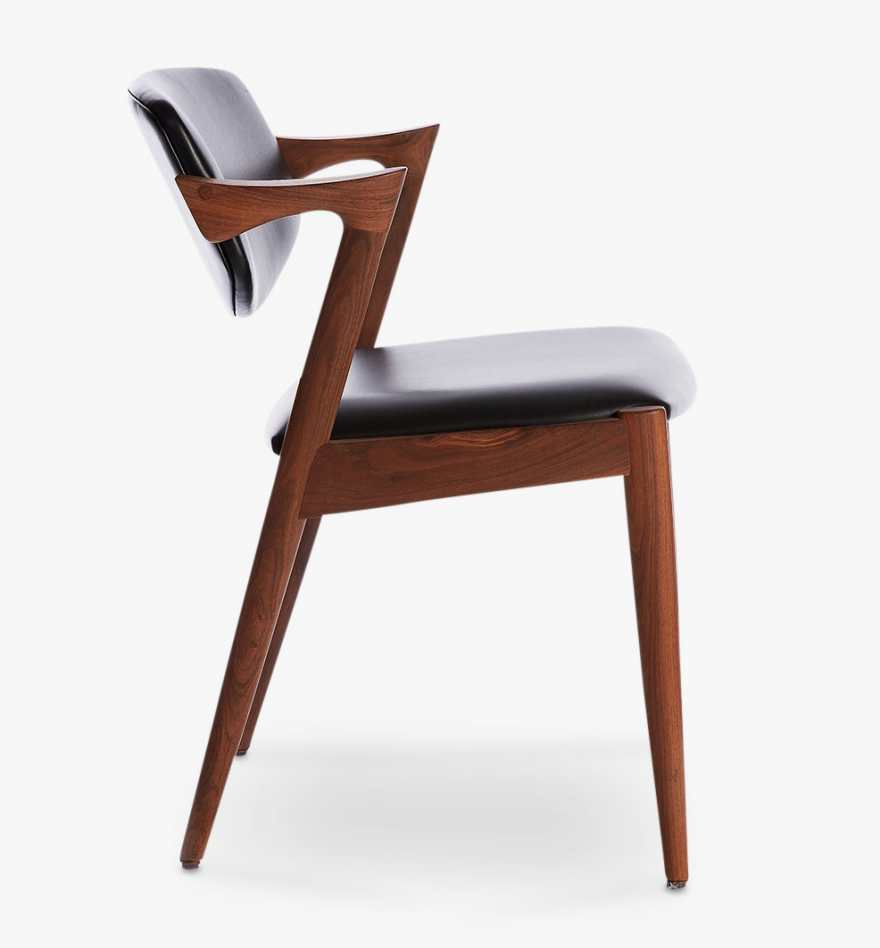
MCM Furniture Design History: Kai Kristiansen, Danish Modern's Last Living Legend
Still designing at 87 years old
 Enter a caption (optional)
Enter a caption (optional)In the last MCM Furniture Design History post, we mentioned that Kaare Klint founded the furniture design department at the Royal Danish Academy of Fine Arts in 1924 and influenced the next generation of Danish furniture designers. The designer in this week's MCM Pick of the Week, Kai Kristiansen, is one of those designers.
Kristiansen's style, presumably informed by Klint, is known for clean lines, functionalism, and Kristiansen's own outside-the-box thinking.
Born in 1929 in Denmark, Kristiansen began studying under Klint at the Academy in 1949. At the age of 26 Kristiansen had set up his own studio, and produced his first "hit" design in 1955:
 Enter a caption (optional)
Enter a caption (optional)That's the #42 Chair, created for manufacturer Schou Andersen. It was radical at the time in that the rear legs, not the front legs, were what supported the armrests. Also note that the suspended backrest appears to float, with no vertical support members coming into contact with it. This chair is recognized as a classic example of the Danish Modern style.
 Enter a caption (optional)
Enter a caption (optional)Kristiansen scored another hit two years later with the design of a modular wall system. In 1957, three years before Dieter Rams designed the 606 Universal Shelving System for Vitsœ, Kristiansen designed the Reolsystem Wall Unit:
 Enter a caption (optional)
Enter a caption (optional) Enter a caption (optional)
Enter a caption (optional)It was well-received, both domestically and internationally. While much more of a commitment than purchasing a standalone wall unit, the Reolsystem was popular because the end user could arrange and customize a variety of storage components on it to their specific needs.
 Enter a caption (optional)
Enter a caption (optional)The Reolsystem was produced by Danish manufacturer SB Feldballes Møbelfabrik, one of the many manufacturers Kristiansen was contracted by. (Others include Fritz Hansen, Magnus Olesen and FM/Fornem Møbelkunst, who took over production of the Reolsystem in the '60s.) Kristiansen designed chairs, desks, sideboards and wall units. The sideboard that Mid Century Mobler showed us as their Pick of the Week was also produced by SB Feldballes Møbelfabrik:
 Enter a caption (optional)
Enter a caption (optional)This is not one of Kristiansen's smash hits; it is a more workmanlike piece, designed for people's homes rather than a museum, and we must look closely at it to see what is significant about it. First off this piece was designed in the 1960s. To provide some context, let's look at this earlier sideboard designed by Kristiansen in the 1950s, here integrated with the Reolsystem:
 Enter a caption (optional)
Enter a caption (optional)As you can see, both the bureau and the sideboard have legs connected to each other by an apron or stretcher:
 Enter a caption (optional)
Enter a caption (optional)The Find of the Week sideboard, in contrast, has no apron at all. Kristiansen has pared down and minimalized the supporting structure as much as possible; the legs are connected only by two lintels running front to back, and these make the connection to the casework.
 Enter a caption (optional)
Enter a caption (optional)Photographed from this low angle, the lintels, though recessed slightly, are visible:
 Enter a caption (optional)
Enter a caption (optional)However, when seen from the angle at which this unit would most commonly be seen and interacted with--which is to say, standing height--the lintels disappear from view:
 Enter a caption (optional)
Enter a caption (optional)On the thin legs, the casework thus seems to float.
 Enter a caption (optional)
Enter a caption (optional)Like most mid century modern pieces, the casework itself appears seamless. The corners are mitered.
 Enter a caption (optional)
Enter a caption (optional) Enter a caption (optional)
Enter a caption (optional)The faces of the drawers inside are pure form-follows-function, with a gentle curve cut into each face to admit fingers for pulling.
 Enter a caption (optional)
Enter a caption (optional)No fasteners are visible throughout, and the use of materials other than wood is sparing. Felt lines the drawers to prevent objects within from sliding as the drawer is opened, and the tracks that the sliding doors run on are presumably metal, but that's about it.
 Enter a caption (optional)
Enter a caption (optional)In the photo directly above, you can also see that the sides of the drawers are grooved, to accept the wooden runners affixed to the interior of the case. And looking inside the case, below, we can see three rows of holes beneath the two existing drawers:
 Enter a caption (optional)
Enter a caption (optional)These are undoubtedly to support additional runners, and it's likely that the customer had the choice, at the time of purchase, to specify how many drawers they wanted the unit to contain. It might not be as configurable as the Reolsystem, but there was still a measure of customization available.
Kai Kristiansen is alive today, and still actively engaged in design work, well into his 80s. Just last year Kristiansen released a new line of entryway drawers called Entre, produced by Danish manufacturer Great Dane.
 Enter a caption (optional)
Enter a caption (optional) Enter a caption (optional)
Enter a caption (optional) Enter a caption (optional)
Enter a caption (optional) Enter a caption (optional)
Enter a caption (optional) Enter a caption (optional)
Enter a caption (optional) Enter a caption (optional)
Enter a caption (optional)You can read the story behind those here.
-
oFavorite This
-
QComment
K
{Welcome
Create a Core77 Account
Already have an account? Sign In
By creating a Core77 account you confirm that you accept the Terms of Use
K
Reset Password
Please enter your email and we will send an email to reset your password.

